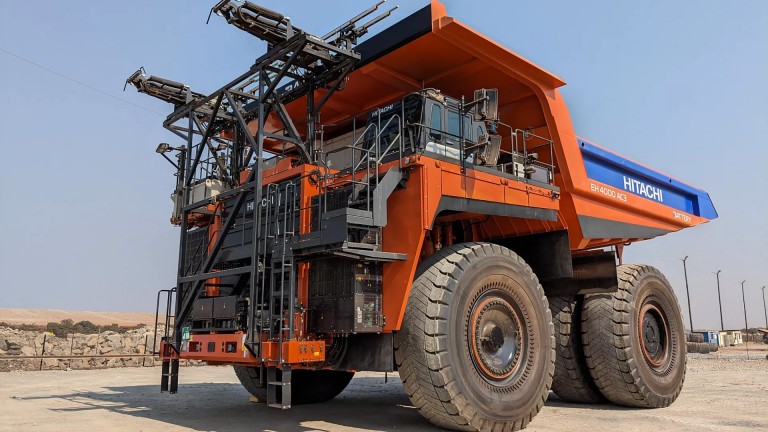“Zeroing in on the future” with innovative technology is Hitachi Construction Machinery’s objective at MINExpo 2024. The Hitachi CM booth showcases the company’s solutions to help mine owners address their most pressing concerns: operating costs, productivity, the environment, and mine safety.
To that end, the company is embracing three zeros. A path toward zero emissions, zero downtime, and zero entry mines to reduce fuel consumption and interruptions, for a lower cost per ton, while enhancing safety by removing employees from mining operation danger zones.
Hitachi’s path to zero emissions
Since Hitachi CM pioneered the hydraulic excavator in 1965, and entered the mining industry 1979, the company has made a lot of progress. Today, the company offers a range of EX-7 wired mining electric excavators that complement conventional EX-7 excavators, helping mine operators lower their total cost of ownership while reducing greenhouse gas emissions. EX-7 electric excavators require less frequent servicing and experience reduced machine downtime by eliminating the diesel engine.
New dump trucks with ECO modes and next-generation capability
When paired with reliable EX5600-7 excavators, the next-generation EH4000AC-5 rigid dump trucks make for a sustainable and efficient mine site, according to the company. EH4000AC-5 dump trucks have been designed to reduce fuel consumption while enhancing productivity, reliability, and safety. Work mode selection allows workers to choose the optimal mode based on the mining site environment and operating conditions. In ECO mode, the engine output is lower than the default setting, resulting in reduced fuel consumption. H/P mode provides higher engine output. This model has also been designed with the potential retrofit expansion to trolley diesel and battery systems, making it next-generation capable. The EH4000AC-5 will have one of the largest payloads in the industry at 242 tons.
Hitachi mining haul trucks offer a retrofittable trolley configuration that allows drivers to alternate between powering the truck in diesel mode and raising the pantograph to power the truck via overhead catenary lines in Trolley Mode. Trolley trucks simultaneously boost production, reduce operating costs and lower greenhouse gas emissions. They climb uphill slopes at approximately twice the speed of diesel trucks and reduce noise emissions while running in trolley mode. While running in trolley mode, the diesel engine runs less, extending the engine life and reducing maintenance costs.
Hitachi has also developed a zero-emission, full-battery trolley dump truck. Drawing electric power from a dynamic charging system allows continuous operation with no stops for recharging. This dynamic charging system minimizes the weight of the battery solution, maximizing the truck’s payload capacity.
The all-battery trolley dump truck utilizes an ABB-supplied onboard battery system and dynamic charging option via pantograph and overhead trolley lines to simultaneously charge the battery and provide energy to power the truck. Regenerative braking also adds charging capabilities to the battery management system.
Fleet management and digital solutions for real-time data to inform practices
The company is adopting a holistic approach in its progress towards zero emissions that goes beyond equipment. Mine sites operate 24 hours a day, seven days a week, and they need management solutions to reduce environmental impact while achieving sustainable resource extraction, according to the company.
Fleet management and digital mining solutions from Wenco, a wholly owned subsidiary of Hitachi Construction Machinery, and Envirosuite, an environmental intelligence company, provide operators real-time data to enable responsible mining practices.
Path to zero mine entry
Limiting employee exposure to danger is possible through mine site automation, such as driverless automated haul trucks. The Hitachi Automated Haulage System (AHS) combines advanced digital technologies and Wenco International Mining System’s fleet management system (FMS) to enable uncrewed operation of mining trucks at open-cut mining pits. The system optimizes route navigation, acceleration, and braking for decreased life-cycle costs.
AHS allows mixed fleet integration with manned fleets while transitioning from conventional to autonomous operations, open interoperability to optimize across entire truck fleets, and the ability to retrofit existing trucks.
On the path to a zero entry mine, Hitachi CM is developing a system for semi-autonomous and remote operation of ultra-large hydraulic excavators. Key features of this system are the digging assist function to support the excavation of ore, and the loading assist function to support an optimized loading cycle. Once complete, this system aims to improve operational performance, and mine sites will benefit from reduced operator burden and increased productivity.
Path to zero downtime
Reducing downtime and extending product life helps mine sites maintain production rates while reducing greenhouse gas emissions. Mine sites can achieve both goals by closely monitoring mining operations and machine health.
With ConSite Mine remote monitoring and remanufacturing services, users can prevent breakdowns and extend the life of their machines. ConSite Mine remotely monitors the condition of large hydraulic shovels and rigid dump trucks, promptly generating alerts when sensors detect abnormalities. One of the features, ConSite Oil, continuously monitors oil conditions to catch issues that occur between oil analysis intervals.
Hitachi CM’s Technological Centers of Excellence (TCoE) remotely monitors and supports mine operations 24 hours a day, 365 days a year from Australia, Japan, and Canada. The same information customers get in their mine control room is monitored in real-time.
Read the full article here

